 James Herriotte
James HerriotteFor The South End
When people visit the Detroit Zoo, typically they go for the usual attractions, lions and tigers — not the eccentric fashion designer Betsey Johnson.
The designer is coming to Detroit, and she isn’t alone. Thursday, Oct. 1 and Friday, Oct. 2 the Detroit Zoo will be host to animals who are fierce in a different way. The event, “Fashion in Detroit,” is the first of its kind in the area. The zoo will showcase national names like Betsey Johnson and Kevan Hall as well as local clothing lines like “Diva Groove” and Kid Rock’s “Made in Detroit.”
While Detroit has its own beat of style, it is not a fashion capital like New York or London. Still, Karen Buscemi, editor of Style Line and the event’s host, thinks this could all change.
“The media coverage this event is getting is crazy, from Women’s Wear Daily to Spin and even CNN money,” Buscemi said.
“Fashion in Detroit” was created by former “Project Runway” contestant Joe Faris as a way for Detroit area designers and others in the fashion community to express their interest in the art of fashion.
“Detroit has always had the passion, the talent and the culture for fashion,” Hodah Salameh, volunteer coordinator and WSU student, said, “but the only missing ingredient has been the drive to display that potential. FID is the force that’s helping Detroit conquer the fashion industry.”
With FID, Detroiters no longer have to read and enviously watch all the lavish shows held during the Fashion Weeks of cities like Paris, New York, and Milan. Better still, most of the designers have some connection to Detroit. Designer Peter Soronen grew up in Farmington and Kevan Hall is a graduate of Detroit’s Cass Technical High School.
While many of the designers to be showcased are not strangers to the runway, be it here or abroad, there is one that sticks out like a sore thumb — Carhartt.
“I’m really interested in what Carhartt is bringing to the table — whether or not they’ll be showing the work wear they’re famous for or their little known street brand, which is famous in Europe,” Angela Wisniewski, owner of Web site “Angela’s Eye … On Metro Detroit’s Style,” said.
The company, known mostly for its work clothes and outerwear, has a slot among some of the more high-end designers like Betsey Johnson. But Carhartt isn’t the only designer bringing something different to the catwalk.
Dana Keaton, a local artist and professor at the College for Creative Studies and Art Institute of Michigan is devoted to bringing back personal customer service once only available to the clients of famous couturiers in Europe. Keaton’s line, “Diva Groove,” is dedicated to custom and specialty designs to satisfy client’s needs. “Diva Groove” is also one of the few Detroit lines to incorporate traditional weaving and fabric into its designs.
“I’m also an artist and I like to put my creativity into each of my designs,” Keaton said.
When asked why she chose to go the route of one of kind creations instead of mass production Keaton referenced one of every fashionista’s worst nightmares.
“No woman likes to wear the same thing as somebody else,” she said. “I’d hear stories all the time of ‘I walked in and she had on the same thing.’ ‘Diva Groove’ eliminates that.”
As an up-and-coming designer, Keaton looks forward to the future of Detroit’s fashion scene, thanks to “Fashion in Detroit.”
“For years we’ve been trying to build Detroit’s fashion industry,” she said. “I think ‘Fashion in Detroit’ finally got it right.”
































